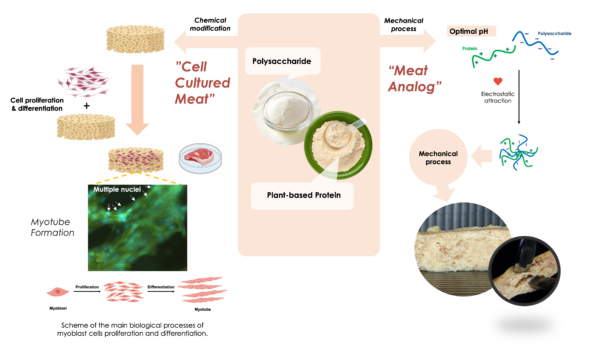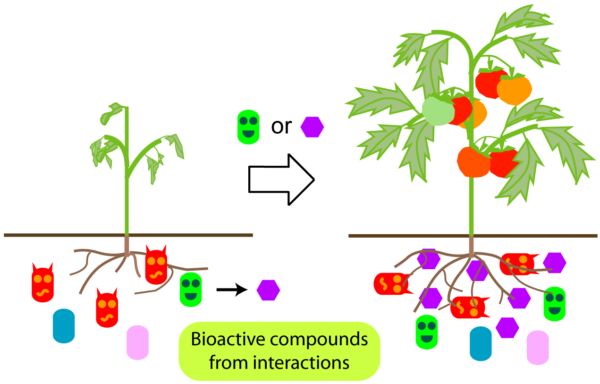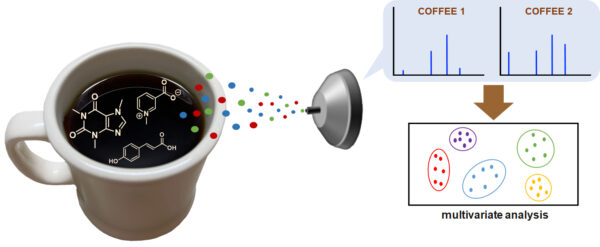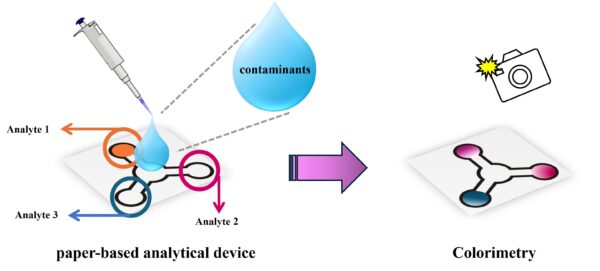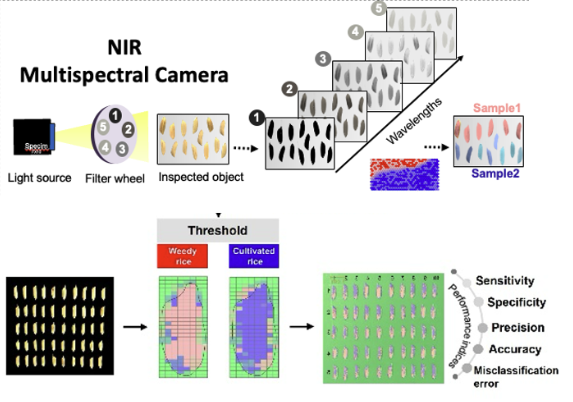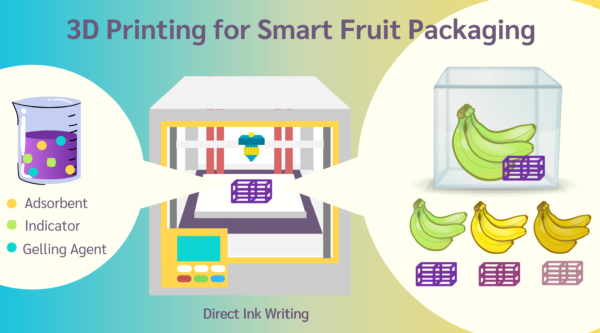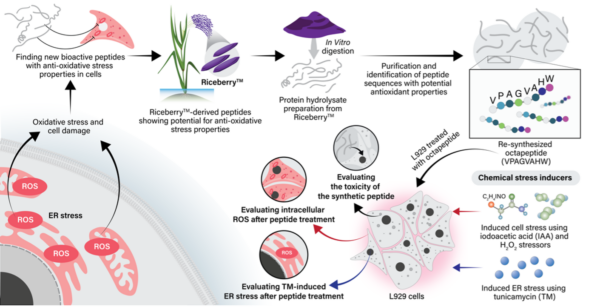Research Themes
Food and Agricultural Chemistry
Prof. Voravee P. Hoven
Future Food from Bio-derived Polymer
Due to the awareness of global environmental issues, the quest for sustainable and ethical food sources has driven innovation in both cell-cultured meat and plant-based meat alternatives. This project focuses on the design and development of advanced biopolymer-based materials that support cell growth for cultured meat and create innovative meat alternatives. By combining polymer chemistry and food science, we can address the challenges of texture, nutritional profile, and scalability in next-generation meat products.
Assoc. Prof. Nawaporn Vinayavekhin
Combating microbial plant pathogens using natural products from rhizospheric microbe-microbe interactions
Microbial plant pathogens pose a significant threat to agriculture, causing extensive crop losses and reducing food security. Traditional methods of combating these pathogens often rely on chemical pesticides, which can have detrimental environmental effects and lead to resistant pathogen strains. Therefore, there is a growing need for sustainable and effective alternatives. This research aims to combat microbial plant pathogens by harnessing novel natural products derived from rhizospheric microbe-microbe interactions. These interactions are a rich source of unique compounds with potential antimicrobial properties. Initially, we will identify and isolate natural products produced by interactions between biocontrol microbes, microbial plant pathogens, and other rhizospheric microbes using LC-MS-based untargeted metabolomic analyses. The antimicrobial activities of these isolated products will then be tested against plant pathogens, and their effects will be evaluated in plant pots and field trials. Furthermore, we will study the biosynthetic and stimulated mechanisms of these natural products using RT-PCR and other appropriate techniques. This research seeks to offer innovative and sustainable solutions for managing plant diseases, enhancing crop health, and improving agricultural productivity.
Assoc. Prof. Thanit Praneenararat
Geographical profiling and authentication of Thai food and agricultural products by chemical analysis
The research interest in my laboratory deals with the application of mass spectrometry-based techniques to collect chemical data in foods and agricultural products. The obtained data were then used to classify products based on attributes of interest such as geographical origins, processing types, and possible adulteration – all of which were performed with an aid of multivariate analyses. This research is a unique experience to combine skills in analytical instrumentations, data sciences, and some bit of sample preparation of organic samples. Among prominent subjects of study in the lab include durian, Thai coffees, and pineapples.
Assoc. Prof. Monpichar Srisa-Art
Minituarised analytical methods for determination of contaminants in food/agricultural products
Contaminants e.g. bacteria, microorganisms, pesticides, chemicals and toxic metals in food and agricultural products are harmful for human health, causing diseases or illness. Therefore, highly sensitive and selective detection platforms for analysis of contaminants are crucial for public safety and environment protection. Accordingly, paper-based analytical devices (PADs) have attracted considerable attention to be developed as analytical tools for monitoring contaminants in food and agricultural products. PADs offer the key advantages including simplicity, reliability, inexpensiveness, rapid analysis, portability, ease of fabrication and disposability. Coupled with colorimetric detection, PADs have shown the ability to be used as portable platforms, which are highly suitable for on-site measurements or analysis in low-resource settings.
Assoc. Prof. Kanet Wongravee
Application of NIR combined with Chemometrics for quality assessment of food/agricultural products
A new analytical approach using SOMs in hyperspectral data is proposed for classification purposes. The developed supervised SOMs were applied on pair-wise HSI to establish the supervised global SOM map of the reference classes. All parameters involving scaling value and map size were systematically optimized. The pair-wise pixels of an unknown sample were projected onto the global SOM map in order to determine the class of each image pixel. The class of each pixel was projected onto the image by a simple display using the color scale . Thereafter, the class of each sample image was determined using the golden ratio of the projected color on the image with a receiver operating characteristic (ROC) curve. This approach is more appropriate for real implementations using NIR-HSI systems within the wavelength region of 1000–1600 nm for agricultural seed quality as it classifies based on individual seed images.
Assist. Prof. Benjaporn Narupai
Smart fruit packaging
The development of packaging for agricultural products has gained significant attention in recent years. Ensuring the quality and safety of these products is essential to guarantee consumer satisfaction and safety. This has led to the rise of smart packaging, which incorporates intelligent features to enhance product value, such as ripeness indicators and gas leak detectors. Our team has developed 3D-printed bio-based polymers designed to extend the shelf life of fruits and detect ethylene gas visible to the naked eye. Our goal is to transform conventional packaging into smart packaging that not only adds value to the products but also reduces the rate of fruit spoilage during export.
Dr. Chanat Aonbangkhen
Protective Effects of an Octapeptide Identified from Riceberry™ (Oryza sativa) Protein Hydrolysate on Oxidative and Endoplasmic Reticulum (ER) Stress in human Cells
Reactive oxygen species (ROS) play a critical role in oxidative stress and cellular damage, underscoring the importance of identifying potent antioxidants. This research focuses on the antioxidant capabilities of plant-derived peptides and their protective effects against oxidative and endoplasmic reticulum (ER) stress in human cells. By simulating human digestion, the protein hydrolysate was generated, from which antioxidant peptides were isolated using OFFGEL electrophoresis and LC-MS/MS. Notably, an octapeptide from the hydrolysate demonstrated significant antioxidant activity, particularly against oxidative stress induced by iodoacetic acid (IAA) or hydrogen peroxide (H2O2) and ER stress caused by tunicamycin (TM) in L929 cells. This peptide’s effectiveness was evident in its dose-dependent ability to enhance cell viability and mitigate stress effects, although its efficiency varied with the stress inducer. Our study suggests that plant-derived peptides could serve as a promising natural antioxidant with potential benefits for health promotion and applications in the food industry, offering an environmentally friendly alternative to synthetic antioxidants.


